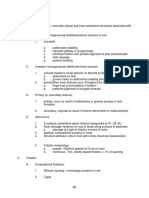Little Dot MK IV SE Reference Guide
Little Dot MK IV SE Reference Guide
Uploaded by
zmender14Copyright:
Available Formats
Little Dot MK IV SE Reference Guide
Little Dot MK IV SE Reference Guide
Uploaded by
zmender14Original Description:
Copyright
Available Formats
Share this document
Did you find this document useful?
Is this content inappropriate?
Copyright:
Available Formats
Little Dot MK IV SE Reference Guide
Little Dot MK IV SE Reference Guide
Uploaded by
zmender14Copyright:
Available Formats
Little Dot MK IV / SE
Little Dot MK IV / SE Headphone Amplifier/Pre-Amplifier
Reference Guide
Version 1.2
Last Updated 2.25.2014
The latest version of this Reference Guide can always be found here
Safety Notice
1
2
3
4
5
6
7
Risk of electric shock - do not open chassis during operation.
Do not use inside poorly ventilated areas with restricted airflow (such as within cabinet).
Do not use near heat sources, or any other apparatus that produces heat.
Clean only with a dry cloth, and do not use near water or moisture.
Unplug during lightening storms or when unused for long periods.
For best protection from power spikes/brown outs, use with a battery backup and/or surge protector.
Amplifier may be hot during operation. Do not touch vacuum tubes or chassis during operation or
immediately after operation.
8 Keep away from small children and/or pets.
9 In case of damage or malfunction, suspend usage immediately, unplug the power source, and refer
all servicing to qualified personnel. Please contact Little Dot for assistance.
Basic Troubleshooting
Ground Loops: In systems where the components have multiple paths to ground, you may notice a 60
Hz hum on the Little Dot output. Please only use a cheater plug power-cord as the last resort, as this
can be a safety hazard. To resolve ground loop issues, the better method would be to use a ground
loop isolator. The ideal method would be to solve the ground loop at its source by connecting all
components to common ground and/or have your electrical wiring checked by a professional electrician.
Swapping Tubes and other changes: To minimize chances of damaging your Little Dot, make sure to
power off, disconnect the power cable, and wait at least 5-10 minutes before attempting swapping tubes,
changing gain settings, or capping/uncapping the jumper switches. This allows the capacitors to fully
discharge.
Plugging/Unplugging Headphones: It is recommended to only plug/unplug your headphones while
your Little Dot is powered off.
Channel Imbalance: Try swapping the left and right side tubes to see if the channel imbalance moves.
If so, continue swapping the tubes as needed to isolate the particular tube thats causing the issue.
Also verify the gain settings are set the same way for both channels.
Static/Noise in one or both channels: Try cleaning the tube pins to free them of oxidation. Also check
for sources of interference nearby such as wireless routers, telephone base stations, and other RF
emitting devices. Check the fuse and re-seat it so that it makes good electrical contact. Move all
switches back and forth several times to loosen them, and then set them securely into position. Both
the switches and fuse can shift during transit. Lastly, try a different power cord than the one included.
Loudness is constant, and volume control does not work for one or both channels: You likely
have your source hooked up to Little Dot pre-amp outputs instead of the inputs. Verify your RCA cables
are connected to the INPUT and try again.
Little Dot does not power on: If you are using the stock power cord, try another. Check the condition
of the fuse located beside the power cord plug and replace if necessary.
General: For general strange behavior (noise, non-functioning channels, etc) please check and re-seat
the fuse. The fact that the amplifier powers on does not necessarily mean the fuse is making
optimal contact. When new, the gain switches can be tight. Move each switch back and forth several
times and then securely set them into position. Swapping the power cord is also a recommended
troubleshooting step.
Vacuum Tube Troubleshooting
Noisy Tubes: Since the tubes used in Little Dot amplifiers can be very old, there is a distinct possibility
the pins have oxidized and therefore can cause hissing, crackling, buzzing, and various other noises
during operation. This is common with vacuum tubes and is nothing to worry about, as there is an easy
remedy. There exists de-oxidizing electronics cleaner (for example Caig deoxIT) which will remove all
hissing and noises in 95% of such cases. It is also good tube practice to regularly clean tube pins with
such de-oxidizing cleaners.
Interference: Interference can be picked up by the tubes and cause odd noises. To minimize
interference, keep your Little Dot isolated from wireless routers, cell phones, telephone base stations,
and other common sources of RF or EMI noise. Generally speaking, the M8161 and other mil-spec
tubes will reject much more interference than the 5654/M8100s.
Isolating Tube Noise: To isolate tube noise, first note which channel the noise appears in, and then
power off the amplifier and wait 5-10 minutes before swapping the front driver tubes. Listen again to
check if the noise has traveled to the other channel. If so, you have isolated the problematic tube. If
not, repeat for the rear power tubes. Problematic tubes may need cleaning/de-oxidizing or replacement.
Signs of Failing Vacuum Tubes:
o
o
o
o
o
Whooshing noise (likely a faulty driver tube)
Glow changes to purple (not blue) color
Tube once had a mirrored or silver tip, but now is white or clear (lost vacuum)
Scratching/high frequency distortion
Gain has decreased significantly
First Time Use
Before powering on your Little Dot for the first time, please make sure the tubes are all securely inserted into
their sockets as they can become loose during transit. It is also recommend to first clean the tube pins with
electronics or de-oxidizing cleaner to remove any grime or oxidation that may have occurred. While the
tubes are cleaned in the factory with isopropyl alcohol, a de-oxidizing agent is not used since we do not
have access to such compounds in China at the current time.
Burn-In
While its OK to burn-in your Little Dot amplifier, it is not recommended to leave your Little Dot running 24
hours a day. We suggest for every 8 hours of burn-in, you allow your Little Dot to cool-down for 30 minutes
to an hour. Please also refrain from burning-in your Little Dot in an area with little to no airflow, and can
easily build up heat. Any music, sine sweeps, or pink noise is acceptable, and the volume should be just
slightly higher than listening volume. Headphones should be plugged in during burn-in.
Little Dot MK IV / SE Introduction
Thank you for purchasing the Little Dot MK IV / SE vacuum tube headphone amplifier! Hope this manual can
help you easily enjoy your Little Dot MK IV / SEs sonic capabilities.
Before you use Little Dot MK IV / SE, please read this manual carefully. If you have some other problem,
please contact us or visit our website www.littledot.net, and we will answer all your questions as soon as
possible.
The All-New Little Dot MK IV is our flagship headphone amplifier/pre-amplifier in the Little Dot MKseries. Boasting a SEPP (OTL) circuit design filled with high quality components such as an ALPS-27
potentiometer, Nichicon, Rubycon, and German WIMA/ERO capacitors, the Little Dot MK IV is truly our best
effort yet. Regardless of whether your headphones are 32 ohms or 600 ohms, the Little Dot MK IV can drive
them easily with effortless dynamics (45Vp-p!), subterranean bass, cavernous soundstage, and precise 3-D
imaging.
The Little Dot MK IV also adds in user-tweaking options such as two gain switches to delivery maximum
compatibility with all your headphones, regardless of impedance or sensitivity. Also available for the very
first time in a Little Dot amplifier, is an internal jumper to allow use with a wider range of driver tube-rolling,
including the EF92, CV131, WE403A/B, GE5654, M8100, CV4010, EF95, 6JI as well as all equivalents,
derivatives, and direct replacements to these vacuum tubes!
The Little Dot MK IV SE is a special edition version (limited 500 sets) of the Little Dot MK IV which includes
Solen input capacitors, precision Vishay-Dale resistors in key points, a Neutrik headphone jack upgrade, as
well as American CMC or Van Den Hul RCA jacks. The SE version also replaces the normal MK IV vacuum
tubes with M8100 driver tubes and 6H30PI (Gold-Pin) power tubes.
Little Dot MK IV / SE Technical Specifications
Frequency response: 10 hz~100 KHz (-1dB)
THD+N: 0.1% (100 mW @ 300 ohm)
Power Output:
500 mW @ 300/600 ohm
300 mW @ 120 ohm
100 mW @ 32 ohm
Variable Gain: 3,4,5, or 10x
Recommended Load Impedance: 32 ohm~600 ohm
Input Impedance: 50K ohms
Pre-Amplifier Output Impedance: 500 ohms
Pre-Amplifier Gain: 3-10x (also controlled via gain switches)
Pre-Amplifier Voltage: 10V RMS
Power Consumption: 30W (228W * 0.133A)
Pre-Amplification circuit includes both driver and power tubes
Driver Tubes: 2x JAN 5654 (MK IV) or 2x M8100 (MK IV SE)
Power Tubes: 2x Soviet 6H30EH (MK IV) or 2x 6H30PI Gold-Pin (MK IV SE)
High quality aluminum chassis
Neutrik Headphone Jack (SE version only)
American CMC/Van Den Hul RCA Jacks (SE version only)
Dimensions (Metric): 320mm deep by 220mm wide by 143mm high
Dimensions (English): 12.6 inches deep by 8.66 inches wide by 5.62 inches
Weight: 3.5 Kg or 7.7 lbs
1 Year Little Dot Warranty (2 Year Little Dot Warranty for MK IV SE)
Little Dot MK IV / SE Gain Control
The Little Dot MK IV / SE has two internal, red DIP gain switch boxes, which controls the gain of the
amplifier. You can access the gain switches through the center oblong hole on the bottom of the amplifier.
Please power off the amplifier, and unplug it for at least 10 minutes before attempting to change the gain
settings (to ensure capacitors have fully discharged).
Each red box (that has two switches on it) controls the gain for its particular channel. Under most normal
circumstances, you would want the same gain in both channels so please remember to configure the
switches on each red box identically with respect to the other:
Switch 1 Position
OFF
Switch 2 Position
OFF
Gain
10
ON
OFF
ON
OFF
ON
ON
5
4
3
Recommendation
Low impedance and/or low
sensitivity headphones
Medium impedance/sensitivity
Medium impedance/sensitivity
High impedance and/or high
sensitivity
Note: The gain settings also affect the pre-amplifier output.
These gain settings are recommendations only and there is no correct gain for any particular headphone.
You are encouraged to test each setting out with your headphone(s) to determine which setting sounds best
for you.
Little Dot MK IV / SE Pre-Amplifier Use
The Little Dot MK IV / SE is not to be used with a DC or direct coupled power amplifier. Doing so
may result in damage to your Little Dot and/or downstream components!
The pre-amplification signal in the Little Dot MK IV / SE includes both the driver and power tubes for better
compatibility with power amplifiers with low input impedance (for example, transistor-based power amps).
Always power on your Little Dot MK IV / SE pre-amplifier before you power on your connected power
amplifier as this is good practice for any pre-power combination (i.e. power on components from upstream to
downstream). It is also highly recommended to wait at least a minute after powering on your Little Dot
before turning on your power amplifier so that the Little Dots tubes have time to stabilize.
When powering your system off, always switch everything off from downstream to upstream, i.e. first turn off
your power amplifier, then your pre-amp, and finally your source.
For best sound quality and lowest noise, first maximize your sources output level without introducing gain
(i.e. to 0 dB), and then set your Little Dot MK IV / SEs volume to a relatively high level. Amplification done
at the pre-amp stage will result in less noise than amplification done at the power amplifier stage (if the
amplifier you are using as a power amp has volume control at all).
One last thing to remember is keep all your components connected to the same ground, as introducing
another amplifier in a pre-power setup increases the likelihood of introducing a ground loop.
Little Dot MK IV / SE Jumper Pins for Driver TubeRolling
The Little Dot MK IV / SE has three jumper pins per channel that allow two different types of driver tubes.
You can access the pins through the amplifiers bottom panel, and they are located to the sides of the pair of
capacitors closest to the front of the amplifier. Please power off the amplifier, and unplug it for at least 10
minutes before attempting to change the jumper settings.
If the jumper cap is covering pins 1 and 2 (M8100:off), the following driver tubes may be used:
WE403A
5654, CK5654, GL5654, 5591, CV4010, CV5216, CV8246, 6069, CV10442
EF95, M8100, 6AK5W, CV10100, CV8159, CV8225, CV850
6J1
If the jumper cap is placed to cover pins 2 and 3 (EF92 side), the following driver tubes may be used:
EF92, 6CQ6, CV2023, V884, VP6, M8161
EF91, 6AM6, CV10327, CV138, CV1955, CV2195, Z77
CV131, 9D6, W77
Any other equivalents or drop-in replacements for the above-mentioned tubes (both sets) may also be used.
Important Note: While all of the above tubes should technically be equivalent or similar, only the tubes in
bold have officially been tested to be compatible.
Added Note: Some users have reported distortion with the EF91 tube while others have not. We have been
unable to reproduce distortion with Mullard branded EF91s; however this is something to keep in mind when
considering tube-rolling EF91 tubes.
IMPORTANT: Please be careful when setting switches and jumper caps as these are circuit elements and
will be fairly delicate. Using too much force may result in damage!
10
Little Dot MK IV / SE Power Tube Rolling
The Little Dot MK IV uses 6H30EB power tubes by default, while the Little Dot MK IV SE uses 6H30Pi. Both
of these are interchangeable, and you can also use the 6H30P-DR Super-tube as the ultimate replacement!
11
Little Dot MK IV / SE Warranty Information
30 day money back guarantee.
If you are not completely satisfied with your Little Dot amplifier, you can return it to us for a full refund of your
purchase price. Please note the following stipulations for returns:
Little Dot amplifier and all included accessories must be in like-new condition and included.
Shipping insurance is not required; however, you are responsible for all costs in the case of
damage during transit.
Shipping costs are non-refundable.
Warranty
If your Little Dot amplifier does not work properly due to a defect in materials or workmanship, Little Dot
(hereby known as the warrantor) will, for the duration of your specific products warranty period (1 year for
Little Dot MK IV, 2 years for Little Dot MK IV SE), at its option either (a) repair your product with new or
refurbished parts, or (b) replace it with a new or refurbished product. The decision to repair or replace is up
to the warrantor.
This warranty does not cover any product subjected to misuse or accidental damage, and products that
clearly been misused or abused will be subject to cost-based charges for repair.
This warranty only applies to Little Dot amplifiers sold through official channels. Warranties are transferable
to second-hand users, however only labor and parts are covered. Proof of purchase will be required for all
warranty claims.
Vacuum tubes are guaranteed not to DOA or fail within a three-month time-period after purchase. No
additional warranty applies to vacuum tubes either sold by or included as stock through Little Dot.
Your Little Dots warranty period is locked in at the time of purchase. If at a future date the warranty period
for your product model changes, your warranty period will not change. In case of any changes to warranty
period or warranty details, you will be grandfathered in at the warranty period and details specified when you
made your purchase.
Except as provided above or in areas prohibiting thus, Little Dot makes no other warranties either expressed
or implied.
12
You might also like
- Crack 1-1 Manual 09-20-16Document55 pagesCrack 1-1 Manual 09-20-16kfv77drjy5No ratings yet
- Speedball 1-1 Manual 07-23-17Document38 pagesSpeedball 1-1 Manual 07-23-17jose kornelukNo ratings yet
- SPL300 - SPL400: Stereo Power AmplifierDocument14 pagesSPL300 - SPL400: Stereo Power AmplifiervedatNo ratings yet
- Little Dot MK II Reference GuideDocument11 pagesLittle Dot MK II Reference Guidergc999No ratings yet
- Little Dot MK III Reference GuideDocument12 pagesLittle Dot MK III Reference GuideMikko KärkkäinenNo ratings yet
- Little Dot I+ Reference GuideDocument10 pagesLittle Dot I+ Reference GuidenotandreiNo ratings yet
- Rev. ADocument12 pagesRev. AArto SillanpääNo ratings yet
- Ramsey BN9 - Super Sleuth Audio AmplifierDocument16 pagesRamsey BN9 - Super Sleuth Audio AmplifierAl PetitNo ratings yet
- AW100DMBDocument8 pagesAW100DMBchan_thong_1No ratings yet
- Jet City 22h Manuel Utilisateur en 51362 PDFDocument18 pagesJet City 22h Manuel Utilisateur en 51362 PDFfauconns9132No ratings yet
- JET CITY JCA100H/50H 用户手册Document20 pagesJET CITY JCA100H/50H 用户手册kewenzhenglostNo ratings yet
- RKMKII User ManualDocument6 pagesRKMKII User ManualAyu OkaNo ratings yet
- Ground LoopsDocument2 pagesGround LoopsMajid Mossad100% (1)
- Neo250 500manual9 2007Document16 pagesNeo250 500manual9 2007Andree W. KurniawanNo ratings yet
- Owner's Manual: Blackstar Amplification LTD, Beckett House, 14 Billing Road, Northampton, NN1 5AW, UKDocument39 pagesOwner's Manual: Blackstar Amplification LTD, Beckett House, 14 Billing Road, Northampton, NN1 5AW, UKNebojsa Maric-MaroniNo ratings yet
- Manley NeoClassic 250-100 MonoblockDocument15 pagesManley NeoClassic 250-100 Monoblockalain bocquillonNo ratings yet
- Owner's Manual: High Currentintegrated AmplifierDocument7 pagesOwner's Manual: High Currentintegrated AmplifierLuka TrengovskiNo ratings yet
- MijiDocument10 pagesMijiGUS MACIASNo ratings yet
- Electronic Stethoscope: Home Projects Science RelatedDocument4 pagesElectronic Stethoscope: Home Projects Science RelatedmtariqmasoodNo ratings yet
- Blackstar ID Core HandbookDocument36 pagesBlackstar ID Core HandbookMartin Lee SmithNo ratings yet
- IloudDocument24 pagesIloudd79d56h8g6No ratings yet
- Ds800 Op ManualDocument14 pagesDs800 Op ManualradovanovdNo ratings yet
- TH30 Combo ManualDocument6 pagesTH30 Combo ManualAndreu MachucaNo ratings yet
- SM-900 SM-900: User Guide User GuideDocument23 pagesSM-900 SM-900: User Guide User GuideSchindlerialNo ratings yet
- Sonic Frontiers SFC-1 Control Amplifier Instruction ManualDocument6 pagesSonic Frontiers SFC-1 Control Amplifier Instruction ManualSOSAUDIONo ratings yet
- ALTO Zvucnici SpecifikacijeDocument23 pagesALTO Zvucnici SpecifikacijeGoran Ristic-RileNo ratings yet
- Skytec SP12900ADocument5 pagesSkytec SP12900ABodaNo ratings yet
- HT Soloist: Owner's ManualDocument29 pagesHT Soloist: Owner's ManualzorroNo ratings yet
- User Manual: CE-1070P/1130P/1260P/1360PDocument8 pagesUser Manual: CE-1070P/1130P/1260P/1360PVladimir JelusicNo ratings yet
- Ibanez Thermion Tube Amplifier TN120 SchematicDocument32 pagesIbanez Thermion Tube Amplifier TN120 Schematicbilly07No ratings yet
- HT Club 40 HandbookDocument25 pagesHT Club 40 HandbookFabio CheNo ratings yet
- Quad LS RevisedDocument3 pagesQuad LS RevisedLourdes Rodriguez MarquezNo ratings yet
- How To Wire Up A Power AmplifierDocument10 pagesHow To Wire Up A Power Amplifieropreaandrei1993No ratings yet
- spl400 Stereo Power Amplifier ManualDocument4 pagesspl400 Stereo Power Amplifier ManualRichter SiegfriedNo ratings yet
- Manual de Instrucciónes: MIC MIC MIC MIC MIC MIC MIC MICDocument22 pagesManual de Instrucciónes: MIC MIC MIC MIC MIC MIC MIC MICAaron CalderonNo ratings yet
- Power Amplifier: Owner's Manual Mode D'emploi Bedienungsanleitung Manual de InstrucciónesDocument12 pagesPower Amplifier: Owner's Manual Mode D'emploi Bedienungsanleitung Manual de InstrucciónesAlberto PimentelNo ratings yet
- Caixa Amplifica Stagg 40GAR - DSP - USADocument2 pagesCaixa Amplifica Stagg 40GAR - DSP - USAMarcelo M. MachadoNo ratings yet
- Strobe Troubleshooting GuideDocument5 pagesStrobe Troubleshooting Guide1dsmark27088No ratings yet
- Six Pac ManualDocument9 pagesSix Pac ManualgkoulNo ratings yet
- Extra Lead: User'S ManualDocument8 pagesExtra Lead: User'S Manualmarcopadova254No ratings yet
- GBPPR 'Zine - Issue #19Document101 pagesGBPPR 'Zine - Issue #19GBPPRNo ratings yet
- Technics ST 500Document10 pagesTechnics ST 500Helder MartinsNo ratings yet
- Archon ManualDocument2 pagesArchon Manualrafael.mec.85No ratings yet
- Jabadoo Manual 2012 - FinalDocument12 pagesJabadoo Manual 2012 - FinalLuca SilverentandNo ratings yet
- UL Series ManualV2Document12 pagesUL Series ManualV2AndrewJ73No ratings yet
- Elliott Sound ProductsDocument8 pagesElliott Sound ProductsBrix BauzonNo ratings yet
- Vox Pathfinder P15-P15R ManualDocument12 pagesVox Pathfinder P15-P15R ManualcaimanaterNo ratings yet
- Distribuidor de Audio ECLER DAC110E Manual de InstruccionesDocument28 pagesDistribuidor de Audio ECLER DAC110E Manual de InstruccionesAlbertoGonzálezDuarteNo ratings yet
- Sub Series Manual RevDDocument16 pagesSub Series Manual RevDAntonioPalloneNo ratings yet
- Mesa Boogie Single Rectifier Series 2Document38 pagesMesa Boogie Single Rectifier Series 2Mark Flores100% (1)
- HT-5TH: Owner's ManualDocument25 pagesHT-5TH: Owner's ManualFrancis del RosarioNo ratings yet
- Boston Acoustics Mcs 160 Manual de UsuarioDocument20 pagesBoston Acoustics Mcs 160 Manual de UsuarioPedro García EspinosaNo ratings yet
- Adi Tester Signal Tracer Audio Project 164Document5 pagesAdi Tester Signal Tracer Audio Project 164biotekyNo ratings yet
- TC Ditto Looper Manual EnglishDocument12 pagesTC Ditto Looper Manual Englishjackdawson1990No ratings yet
- Precision Power EQ31 Equalizer-1Document13 pagesPrecision Power EQ31 Equalizer-1Stephane GlaudeNo ratings yet
- GX Series User Manual RevDDocument60 pagesGX Series User Manual RevDStephen_Pratt_868No ratings yet
- A Guide to Vintage Audio Equipment for the Hobbyist and AudiophileFrom EverandA Guide to Vintage Audio Equipment for the Hobbyist and AudiophileNo ratings yet
- Aumark Line Manual 1051-1061-1129 0Document151 pagesAumark Line Manual 1051-1061-1129 0ScribdTranslationsNo ratings yet
- Intel Serial IO - Bring Up Guide and Release Note Rev1p0Document30 pagesIntel Serial IO - Bring Up Guide and Release Note Rev1p0gdfeiu dionwdnNo ratings yet
- Minnesota FirefighterDocument24 pagesMinnesota FirefightersurfnewmediaNo ratings yet
- Digital Change Detection Techniques Using Remote Sensor DataDocument20 pagesDigital Change Detection Techniques Using Remote Sensor Datasantoshborate28025100% (3)
- AttunityReplicate 6 0 0 User Guide PDFDocument707 pagesAttunityReplicate 6 0 0 User Guide PDFmr_driveNo ratings yet
- AME EXAM Module 3 MCQDocument258 pagesAME EXAM Module 3 MCQkunnannNo ratings yet
- TIG ShadowProjector en USDocument4 pagesTIG ShadowProjector en USGoll RonanNo ratings yet
- 2506C-E15Tag3 2506C-E15Tag4: Diesel Engine - ElectropakDocument10 pages2506C-E15Tag3 2506C-E15Tag4: Diesel Engine - ElectropakPlasma ZahidNo ratings yet
- Assignment 1Document3 pagesAssignment 1Wanda AlexanderNo ratings yet
- Concept & Dredging Scenario Presentation 32pDocument32 pagesConcept & Dredging Scenario Presentation 32pkvs1411No ratings yet
- Kerusakan Timming BeltDocument8 pagesKerusakan Timming BeltAgus PrasetyoNo ratings yet
- 8m0208791 DH Dts Quick-Ref 9-22-lrDocument2 pages8m0208791 DH Dts Quick-Ref 9-22-lrJoswyn LopesNo ratings yet
- Rwprorox SL 960Document2 pagesRwprorox SL 960wassim nasriNo ratings yet
- Cet First Round Option EntryDocument7 pagesCet First Round Option EntryKishan MNo ratings yet
- 01 Geography Mains 2019Document7 pages01 Geography Mains 2019ShanuNo ratings yet
- 16F723ADocument286 pages16F723ApexeaiNo ratings yet
- 4.WMS-04-reinforcement Steel Fixing WorkDocument11 pages4.WMS-04-reinforcement Steel Fixing Workamol100% (1)
- 9 Ijaest Vol No.4 Issue No.2 Correlation Between Vertical Electric Sounding and Conventional Methods of Geotechnical Site Investigation 042 053Document12 pages9 Ijaest Vol No.4 Issue No.2 Correlation Between Vertical Electric Sounding and Conventional Methods of Geotechnical Site Investigation 042 053iserpNo ratings yet
- Betalight Tritium Illumination DevicesDocument28 pagesBetalight Tritium Illumination DevicesGautam NatrajanNo ratings yet
- Automotive Engine ElectronicsDocument4 pagesAutomotive Engine Electronicsmachine tunisieNo ratings yet
- Tablet MachineDocument3 pagesTablet MachineAnonymous yBhOAi5UH100% (1)
- Foliation LineationDocument5 pagesFoliation Lineationjavicol70No ratings yet
- 7 Emergency LightingDocument16 pages7 Emergency Lightingabduls03No ratings yet
- Theory and Modeling of Electronic Excitations in NanoscienceookDocument52 pagesTheory and Modeling of Electronic Excitations in NanoscienceookahmedkhidryagoubNo ratings yet
- ADC121S101 Single Channel, 0.5 To 1 MSPS, 12-Bit A/D ConverterDocument18 pagesADC121S101 Single Channel, 0.5 To 1 MSPS, 12-Bit A/D ConverterDaveNo ratings yet
- Gas Companies - Batch 1 - NonusableDocument24 pagesGas Companies - Batch 1 - Nonusablesagar ganatraNo ratings yet
- Emat Lo. 37 Lo. 48Document29 pagesEmat Lo. 37 Lo. 48tanoknoktabalbagNo ratings yet
- 14 Sensor Vibration Switch Sw-18010pDocument2 pages14 Sensor Vibration Switch Sw-18010pgreg rezaNo ratings yet
- Cold Work Steels: Available Product VariantsDocument5 pagesCold Work Steels: Available Product VariantsAnonymous oyUAtpKNo ratings yet
- Vegetable Cutting Machine INRDocument6 pagesVegetable Cutting Machine INRDnyaneshwar Dattatraya PhadatareNo ratings yet

























































































